Cycling Coast to Coast Scotland
 This ride we follow a long awaited passage through the highland Scottish Loch’s, joined together by the Caledonian canal, from the North Sea to the North Atlantic. It's no-longer commercially used, now tourism rules and the canal is mainly navigated by leisure craft, but the route has been enthusiastically adopted by walkers and cyclists following ‘The Great Glen way’. The history of the route is interesting, initially ships had go all the way around John O’Groats to get to the east or west coast, a route cutting straight through Scotland was dreamt about, and in the early 19th century the plan was revitalised for a different reason; the Highland Clearances. Surprise surprise, after kicking the Scottish people off their land in favour of sheep, a mass exodus of people happened, but too many left. Scottish engineer Thomas Telford was given the task of reversing the mass emigration; he concluded by creating jobs in the area, people would stay. The plan was agreed by Parliament and around 1850 the Caledonian canal was completed. Commercially, the venture was not a success, as soon as it began to be profitable; railways pushed boat transport backwards, but it did have a renaissance period.
This ride we follow a long awaited passage through the highland Scottish Loch’s, joined together by the Caledonian canal, from the North Sea to the North Atlantic. It's no-longer commercially used, now tourism rules and the canal is mainly navigated by leisure craft, but the route has been enthusiastically adopted by walkers and cyclists following ‘The Great Glen way’. The history of the route is interesting, initially ships had go all the way around John O’Groats to get to the east or west coast, a route cutting straight through Scotland was dreamt about, and in the early 19th century the plan was revitalised for a different reason; the Highland Clearances. Surprise surprise, after kicking the Scottish people off their land in favour of sheep, a mass exodus of people happened, but too many left. Scottish engineer Thomas Telford was given the task of reversing the mass emigration; he concluded by creating jobs in the area, people would stay. The plan was agreed by Parliament and around 1850 the Caledonian canal was completed. Commercially, the venture was not a success, as soon as it began to be profitable; railways pushed boat transport backwards, but it did have a renaissance period.
Day 1- Bristol to Inverness (flying)
 Both bikes were sent up a few days prior to our arrival using ‘Paisely Freight ©’ and at £27 each it’s an absolute bargain (as EasyJet © costs £40 each), the bikes were to be delivered to our first nights stay at Inverness YHA. It takes about an hour and a half to fly from Bristol to Inverness, and then it’s on the local bus to the centre of Inverness arriving around 1300. Our worst fear was substantiated- the bikes weren't at the YHA, after establishing where they were on the company app, and a few frantic phone calls- we were promised they’d arrive early evening. So nothing left to do but explore the city.
Both bikes were sent up a few days prior to our arrival using ‘Paisely Freight ©’ and at £27 each it’s an absolute bargain (as EasyJet © costs £40 each), the bikes were to be delivered to our first nights stay at Inverness YHA. It takes about an hour and a half to fly from Bristol to Inverness, and then it’s on the local bus to the centre of Inverness arriving around 1300. Our worst fear was substantiated- the bikes weren't at the YHA, after establishing where they were on the company app, and a few frantic phone calls- we were promised they’d arrive early evening. So nothing left to do but explore the city.
Inverness has a great location astride the River Ness which poors into the Beauly Firth Estuary at the northern end of the Great Glen. In the summer the city overflows with visitors intent on monster hunting at nearby Loch Ness, it’s also the epicentre of the UK oil industry (or what’s left of it), but it's worth a visit in its own right. We left the YHA in pouring down weather, it was a short walk to the centre of Inverness. The rain made the buildings look black and drab, but there are some impressive structures here. The stunning steeple on the high street was built in 1791, and can be seen from most places in the city, allowing a point of reference. Crossing the Ness bridge the river was in full flow and looked really high, from this vantage point you can see Inverness castle. The Castle sits on a cliff overlooking River. The red sandstone structure was built in 1836 and today houses the Inverness Sheriff Court. After a short coffee we headed back to the YHA. Back at the hostel the bikes had arrived, we put them together and kicked back with a couple of bottles of beer.
Day 2- Inverness to Invergarry (42 miles)
 We start our day by passing Inverness castle (more of a fortified house) and head towards the River Ness banks, the Great Glen Way riverside path is quite pleasant heading towards Ness islands. Crossing the full river to get to the Caledonian canal, we’re soon out of Inverness into the countryside with rolling mountains in front passing Loch Dochfour and alongside the famous Loch Ness.
We start our day by passing Inverness castle (more of a fortified house) and head towards the River Ness banks, the Great Glen Way riverside path is quite pleasant heading towards Ness islands. Crossing the full river to get to the Caledonian canal, we’re soon out of Inverness into the countryside with rolling mountains in front passing Loch Dochfour and alongside the famous Loch Ness.
On the A82 road alongside the largest Loch of scotland, its not long before we reach Clansman Harbour on Loch Ness. Here you can board tours of the lake and have your picture taken with a plastic Nesse, or you could have a respectful coffee in the Clansman cafe. It’s away from the Ness now slightly inland through Drumnadrochit where there’s the- 'Loch Ness Lodge Hotel, Loch Ness Drumnadrochit Hotel, the Loch Ness Inn and of course the Loch Ness Exhibition Centre'. In fact, there's every merchandise, hotel, shop, every man and his dog, the whole shebang, everything you ever wanted to know about the Loch Ness monster (but were afraid to ask). We travel up and around Urquhart Bay, surrounded by forrest we drop down to the ruined 16th century Urquhart Castle. Urquhart played a role in the Wars of scottish Independence in the 14th century and is now one of the most-visited castles in scotland. The narrow fast A82 twists and winds up and down, I'd hate to travel this route in the mid-summer, full of coaches, cavarans, buses and motor-homes, on the main 'Lands end-John O'Groats' route, it's so dodgy for bikes. At Invermoriston is a fantastic bridge built in 1813, the bridge was part of the main road between Drumnadrochit and Fort Augustus, but its attraction is it’s precariously balanced on a massive undercut rock, one good flood and it’s gone.
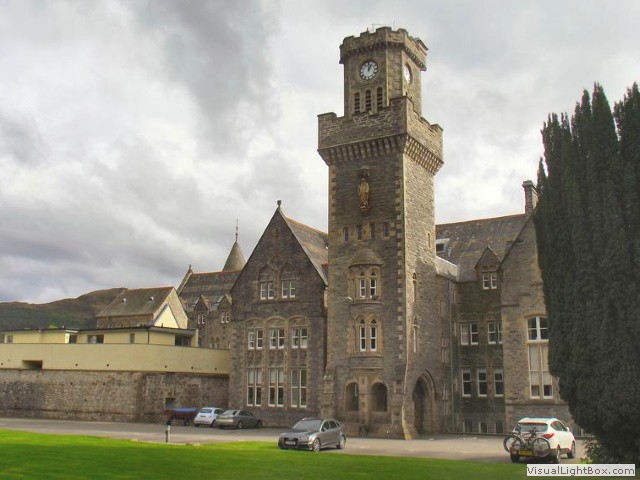 We're now near Fort Augustus, an ancient highland military stronghold, it certainly is a magical place almost sunk into heather covered mountains, changing colour with the seasons. Coffee time in a glorious location at Fort Augustus the Lochside Boathouse Restaurant. In 1876 a Benedictine Order of Monks built a Monastery here on the southern end of Loch Ness, now called the Highland club. Fort Augustus was also the terminus for the North British railway line which ran from Invergarry to Fort Augustus. There's loads of locks here, each of the locks measures 180 feet in length and the lock gates were built with iron from Derbyshire. The five locks were eventually completed in 1820. Near Aberchalder you could cross over and ride on a trail along Loch Oich, but then we’d miss Invergarry Castle (which is tomorrow), we reached our stop for tonight- The Glen Albyn Lodge. Though the fun doesn’t stop there (metaphorically speaking), dinner tonight is just down the road at Glengarry Castle Hotel, so after a shower we trotted down the road. Over a elevated arched bridge is chocolate box of a cottage, gatehouse to the Glengarry Castle Hotel, which was built in 1869. The hotel reeks of nobility and it’s a princely price to stay here, but the restaurant is excellent and reasonably priced.
We're now near Fort Augustus, an ancient highland military stronghold, it certainly is a magical place almost sunk into heather covered mountains, changing colour with the seasons. Coffee time in a glorious location at Fort Augustus the Lochside Boathouse Restaurant. In 1876 a Benedictine Order of Monks built a Monastery here on the southern end of Loch Ness, now called the Highland club. Fort Augustus was also the terminus for the North British railway line which ran from Invergarry to Fort Augustus. There's loads of locks here, each of the locks measures 180 feet in length and the lock gates were built with iron from Derbyshire. The five locks were eventually completed in 1820. Near Aberchalder you could cross over and ride on a trail along Loch Oich, but then we’d miss Invergarry Castle (which is tomorrow), we reached our stop for tonight- The Glen Albyn Lodge. Though the fun doesn’t stop there (metaphorically speaking), dinner tonight is just down the road at Glengarry Castle Hotel, so after a shower we trotted down the road. Over a elevated arched bridge is chocolate box of a cottage, gatehouse to the Glengarry Castle Hotel, which was built in 1869. The hotel reeks of nobility and it’s a princely price to stay here, but the restaurant is excellent and reasonably priced.
Day 3- Glengary to Kinlochmore (41 miles)
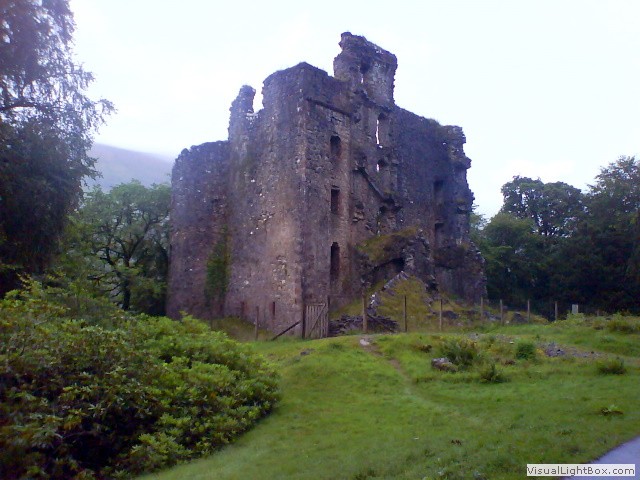 Today we’re staying with an old friend in Kinlochmore so off we go. Invergarry castle was taken over so many times the historians have lost count, today it’s a shell of its former glory having been attacked so many times, but it’s worth a photo. Five minutes after leaving our digs, the heavens opened up, and I’m talking torrential rain, but we had no choice but to continue. On a small gravel track we follow the Caledonian canal, the rain beats down on the water and the mountain mist (though still amazing) closes down the views. The path goes into a wood and we could be anywhere as we cant see the wood for the trees, until it opens up again and we’re at Laggan Locks. We precariously cross the locks here and ride along the Great Glen Cycleway on the east coast of Lock Lochy (I think they couldn’t think of a name for this one) down to Gairlochy on the B8005. On this car free country road you can see Coire Ceirsle hill range, a tremendous sight and to our eyes more of a mountain range than a hill.
Today we’re staying with an old friend in Kinlochmore so off we go. Invergarry castle was taken over so many times the historians have lost count, today it’s a shell of its former glory having been attacked so many times, but it’s worth a photo. Five minutes after leaving our digs, the heavens opened up, and I’m talking torrential rain, but we had no choice but to continue. On a small gravel track we follow the Caledonian canal, the rain beats down on the water and the mountain mist (though still amazing) closes down the views. The path goes into a wood and we could be anywhere as we cant see the wood for the trees, until it opens up again and we’re at Laggan Locks. We precariously cross the locks here and ride along the Great Glen Cycleway on the east coast of Lock Lochy (I think they couldn’t think of a name for this one) down to Gairlochy on the B8005. On this car free country road you can see Coire Ceirsle hill range, a tremendous sight and to our eyes more of a mountain range than a hill.
The road leads us to Neptunes staircase a series of nine locks set in the shadow of Ben Nevis. We crossed the River Locky and had a mooch around the ‘old Inverlochy Castle’. As my chum and I like the occasional tipple we decided to visit Ben Nevis Distillery, just up the road. Now a little tipsy, it's along the Fort William estuary through Druimarbin where the road becomes relatively narrow. We had a quick detour to the Corran ferry terminal as the views were supposed to be incredible, they were. At Ballachulish Bridge we turn left and follow the north coast of Lock Leven, there were strange square structures in the water, which we later found out was farmed salmon. We continued following a twisting road to Kinlochmore with the misty Creag Chaise and Torr Garbh in the distnce to arrive at the Little Yoke B&B, our stop for tonight. Rarely have I seen such a beautiful combination of steep craggy mountains surrounding lakes (or lochs up here), it was simply breathtaking, I'll bet this place is 'something else' in the winter snow.
Day 4- Kinlochmore to Oban (33 miles)
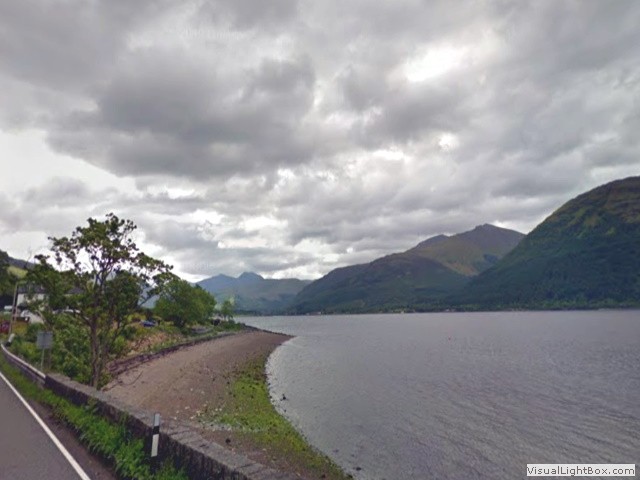 It’s never a good idea to ride the bike the day after visiting an old friend. Back on the road again along the A828 on the south coast of Loch Linnhe with the wonderful named- Mam Chullaich and Meal a' Chaorainn mountains in the distance. At Glencoe we cross a small river on an old bridge, from here you can see all the way down the loch to Beinn Leamhain mountain on the far side of Loch Linnhe. The spectacular valley of Glen Coe has a sinister past as the site of a 17th-century massacre which saw 38 members of the MacDonald Clan hunted to death in the snow. Now on a dedicated cycle path we turn west near Portnacroish and at first we follow the road with restricted views until we see the fantastic remains of Castle Stalker, cragfast on a solitary island.
It’s never a good idea to ride the bike the day after visiting an old friend. Back on the road again along the A828 on the south coast of Loch Linnhe with the wonderful named- Mam Chullaich and Meal a' Chaorainn mountains in the distance. At Glencoe we cross a small river on an old bridge, from here you can see all the way down the loch to Beinn Leamhain mountain on the far side of Loch Linnhe. The spectacular valley of Glen Coe has a sinister past as the site of a 17th-century massacre which saw 38 members of the MacDonald Clan hunted to death in the snow. Now on a dedicated cycle path we turn west near Portnacroish and at first we follow the road with restricted views until we see the fantastic remains of Castle Stalker, cragfast on a solitary island.
Now at the northern edge of Loch Creran it’s through Barcaldine and skirting along the wondrous named Ardmucknish Bay and through (yes through) Oban airport. The scenery is incredibly beautiful as we cross yet another bridge to Connel. As it’s not known when we’re in this part of the world we went off the route to visit Dunstaffnage Castle. My definition of a castle is in the Norman period, most of the scottish castles are fortified manor houses belonging to Clan chiefs. Dunstaffnage Castle is reputed to be one of the oldest standing castle remains in scotland and was the stronghold of the MacDougall Clan. Just through the trees is the remains of the Clan chapel. The cycle paths are good but are sporadic as we re-join another at Dunbeg which leads us to Ganavan Bay and onto Oban.
Day 5- Oban to Glasgow (train)
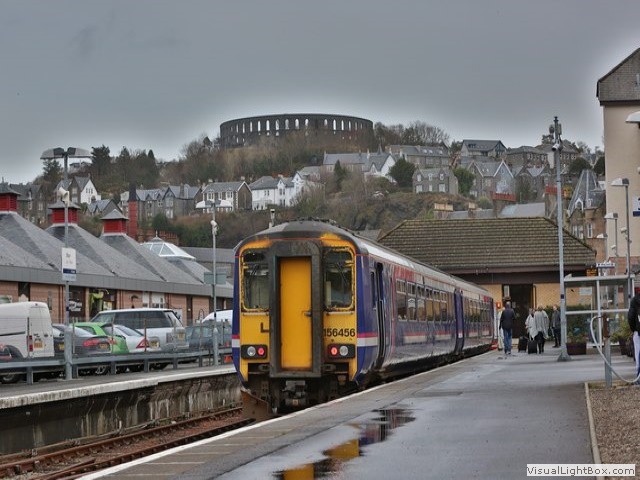 We could have ridden towards Glasgow but it’s three and half hours by train and I rave about some rail journeys, but OMG this one is not to be missed. It retraces our route to Connel and follows Loch Etive for a short while, then sits below the mighty Meal l' Cuanail mountain through the ‘pass of Brander’ and past Cruachan waterfalls which plunges down the side of Ben Cruachan towards the river Awe. We pass over the Bridge of Awe and the water reflects a mirror image of the green mountains.
We could have ridden towards Glasgow but it’s three and half hours by train and I rave about some rail journeys, but OMG this one is not to be missed. It retraces our route to Connel and follows Loch Etive for a short while, then sits below the mighty Meal l' Cuanail mountain through the ‘pass of Brander’ and past Cruachan waterfalls which plunges down the side of Ben Cruachan towards the river Awe. We pass over the Bridge of Awe and the water reflects a mirror image of the green mountains.
Turning south east onto marshland is the jewel in the crown of this route- Kilchurn Castle. Built by the Campbell Clan in 1432, its five-storey tower dominates the panorama and appears to float on the Loch Awe water. We join the West highland main route at Crianlarich and follow the river Falloch to look down on the massive Loch Lomond. We have to swap sides of the carriage to view Loch Long and Loch Gare. Now we’re following the Firth of Clyde, a massive former ship building area. At Kilpatrick the line becomes swamped by urban environment as we roll into Glasgow Queens street. This has to be one of the most scenic routes I’ve ever travelled on.
-
Gallery
 Why not have a look at the gallery relating to this ride. Click the image or the title.
Why not have a look at the gallery relating to this ride. Click the image or the title. -
Inverness
 In WW2 the British fleet were anchored at Scapa Flow 150 miles north of Inverness. When the British Navy ships travelled south, they headed for largest city in the scottish Highlands- Inverness. The city became a Ministry of defence protected area only allowing restricted access, this led the city being a German target and was heavily bombed during WW2 acquiring twenty eight German bomber air-raids. There are many old buildings here, but you can see it’s a relativity new rebuilt city.
In WW2 the British fleet were anchored at Scapa Flow 150 miles north of Inverness. When the British Navy ships travelled south, they headed for largest city in the scottish Highlands- Inverness. The city became a Ministry of defence protected area only allowing restricted access, this led the city being a German target and was heavily bombed during WW2 acquiring twenty eight German bomber air-raids. There are many old buildings here, but you can see it’s a relativity new rebuilt city. -
Dochgarroch Lock
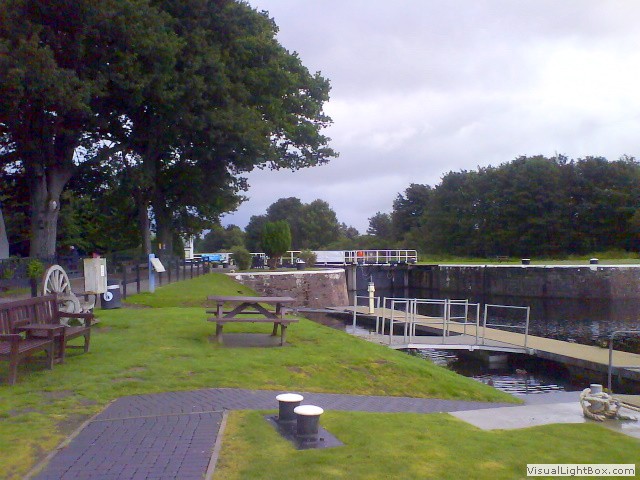 Dochgarroch is the first lock you will go through after you leave
the boat yard in Inverness. From here many of the boat tours depart to tour Loch Ness. There's also a new visitor centre there where we had our first coffee.
Dochgarroch is the first lock you will go through after you leave
the boat yard in Inverness. From here many of the boat tours depart to tour Loch Ness. There's also a new visitor centre there where we had our first coffee. -
Urquhart Castle
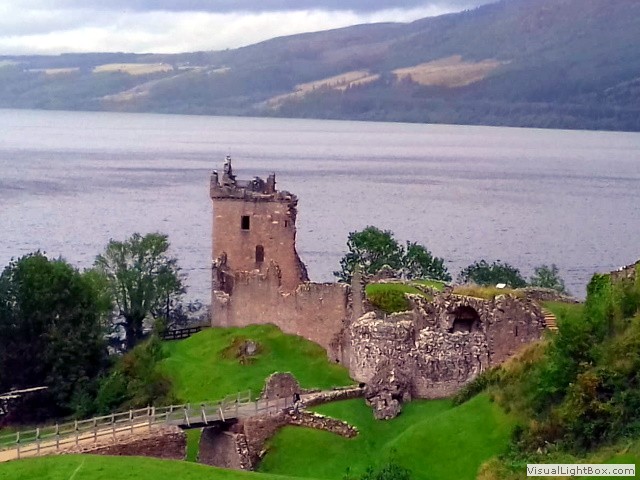 It's £12 to enter the castle (a bit of a rip off) and there's no shortage of tourists williing to pay. The present ruins date from the 13th to the 16th centuries, though built on the site of an early medieval fortification.
It's £12 to enter the castle (a bit of a rip off) and there's no shortage of tourists williing to pay. The present ruins date from the 13th to the 16th centuries, though built on the site of an early medieval fortification. -
Invergarry and Fort Augustus Railway
 It’s amazing such a small railway generated so much tension in the area. The Fort Augustus Pier station was on Loch Ness and tourist traffic was contemplated, however the dominant steamer operator ‘David MacBrayne Ltd’ refused to use it. The North British Railway took over in 1907, but constantly tried to close it, but through locals and acts of parliament, it survived until 1933.
It’s amazing such a small railway generated so much tension in the area. The Fort Augustus Pier station was on Loch Ness and tourist traffic was contemplated, however the dominant steamer operator ‘David MacBrayne Ltd’ refused to use it. The North British Railway took over in 1907, but constantly tried to close it, but through locals and acts of parliament, it survived until 1933. -
Pine Marten
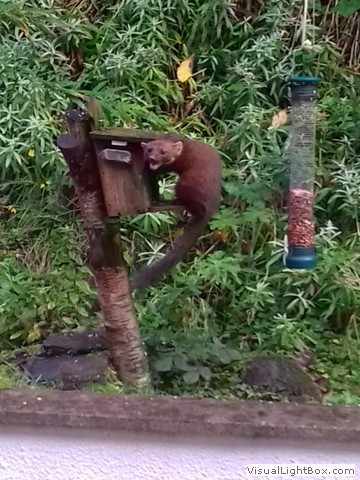 Once found across Britain, the pine marten was prone to persecution for its fur, until relatively recently. Though, it has recovered a little from a dramatic decline, the species is still rare. The B&B owner told us how vicious they are and not to go near them. Click the image for larger view.
Once found across Britain, the pine marten was prone to persecution for its fur, until relatively recently. Though, it has recovered a little from a dramatic decline, the species is still rare. The B&B owner told us how vicious they are and not to go near them. Click the image for larger view. -
The well of seven heads
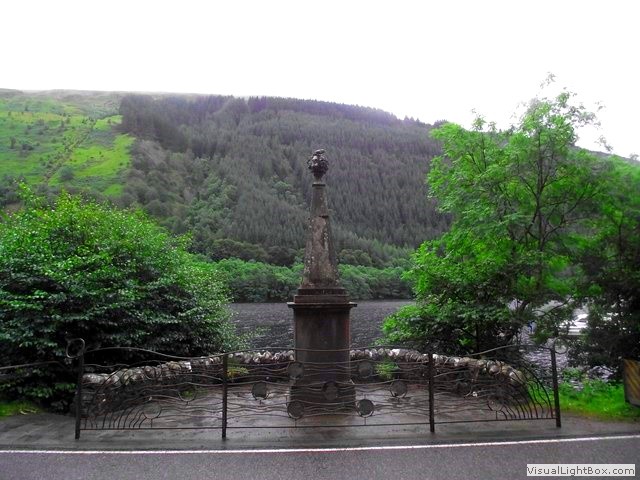 The chief of the Clan MacDonald in a series of revenge killings, severed seven clan chief heads and washed them in a nearby well before presenting them to Invergarry castle. Click image for better view.
The chief of the Clan MacDonald in a series of revenge killings, severed seven clan chief heads and washed them in a nearby well before presenting them to Invergarry castle. Click image for better view. -
Neptune's Staircase
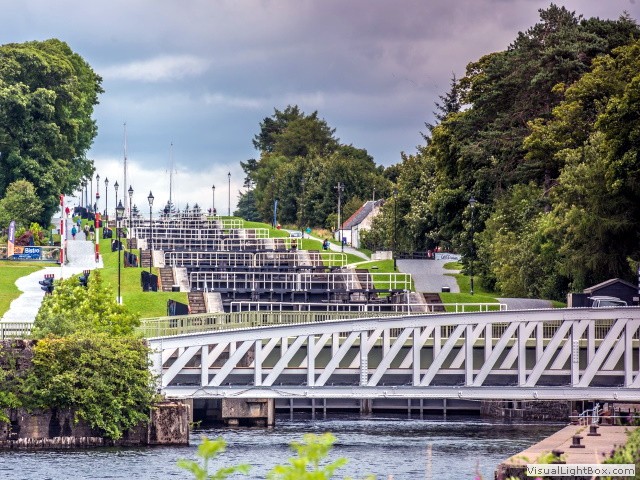 It is the longest staircase lock system in Britain, conceived by the engineer Thomas Telford after the government asked him to look at measures which might stem emigration from the Highlands. Unfortunately it was redundant before it was completed and never saw the trade it was designed for, now it it's preserved by tourists.
It is the longest staircase lock system in Britain, conceived by the engineer Thomas Telford after the government asked him to look at measures which might stem emigration from the Highlands. Unfortunately it was redundant before it was completed and never saw the trade it was designed for, now it it's preserved by tourists. -
The Electric Village
 Powered by a hydroelectric scheme situated in the mountains above, made Kinlochleven the first village in the world to have every house connected to electricity, coining the phrase 'The Electric Village'.
Powered by a hydroelectric scheme situated in the mountains above, made Kinlochleven the first village in the world to have every house connected to electricity, coining the phrase 'The Electric Village'. -
Castle Stalker
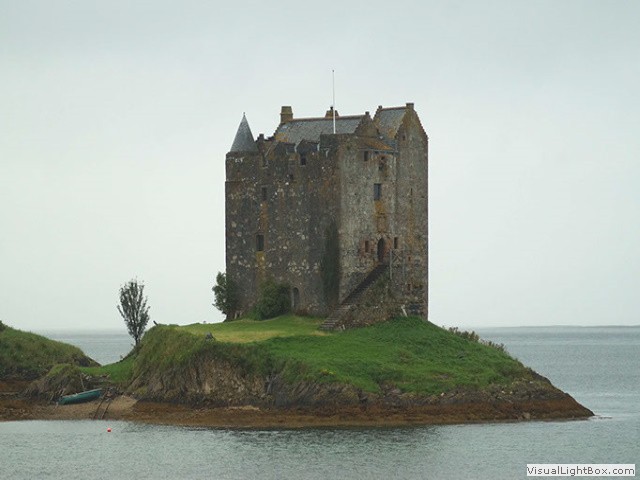 Castle Stalker is a mid-fifteenth century Tower House built on a small islet at the mouth of Loch Laich. Originally owned by the Stewarts, it was lost to the Campbells in 1620 and remained in their hands for almost three centuries. The castle was sympathetically restored in the 1960s/1970s.
Castle Stalker is a mid-fifteenth century Tower House built on a small islet at the mouth of Loch Laich. Originally owned by the Stewarts, it was lost to the Campbells in 1620 and remained in their hands for almost three centuries. The castle was sympathetically restored in the 1960s/1970s. -
Addendum
 I always mention the weather, but Scotland took the biscuit. I couldn’t believe how quickly it changed, from rapid temperature variants to rain and shine in an instant. That said we choose a time of year that was a gamble on the weather, but it was September to avoid the herds of tourists (and midges). The traffic would've been intolerable mid-summer.
I always mention the weather, but Scotland took the biscuit. I couldn’t believe how quickly it changed, from rapid temperature variants to rain and shine in an instant. That said we choose a time of year that was a gamble on the weather, but it was September to avoid the herds of tourists (and midges). The traffic would've been intolerable mid-summer.
We didn’t strictly adhere to the off road route of the ‘Great Glen Way’ and we believe some of the roads were quite dangerous for cyclists, but the route was surprisingly quite flat. The scenery was incredible, I’ve never seen such an abundance of mountainous vistas shrouded in mist coupled with seemingly endless lakes. My cycling cohort mentioned how extraordinarily green the landscape was (probably due to the excess of rain). Well, it was a moist experience, but an exceptionaly enjoyable and fun one.
